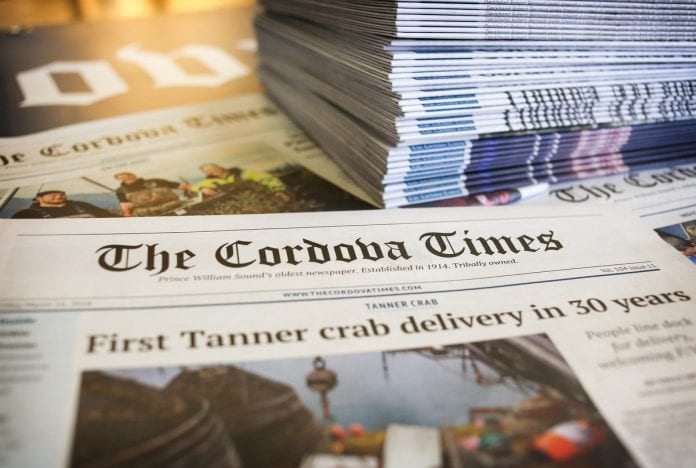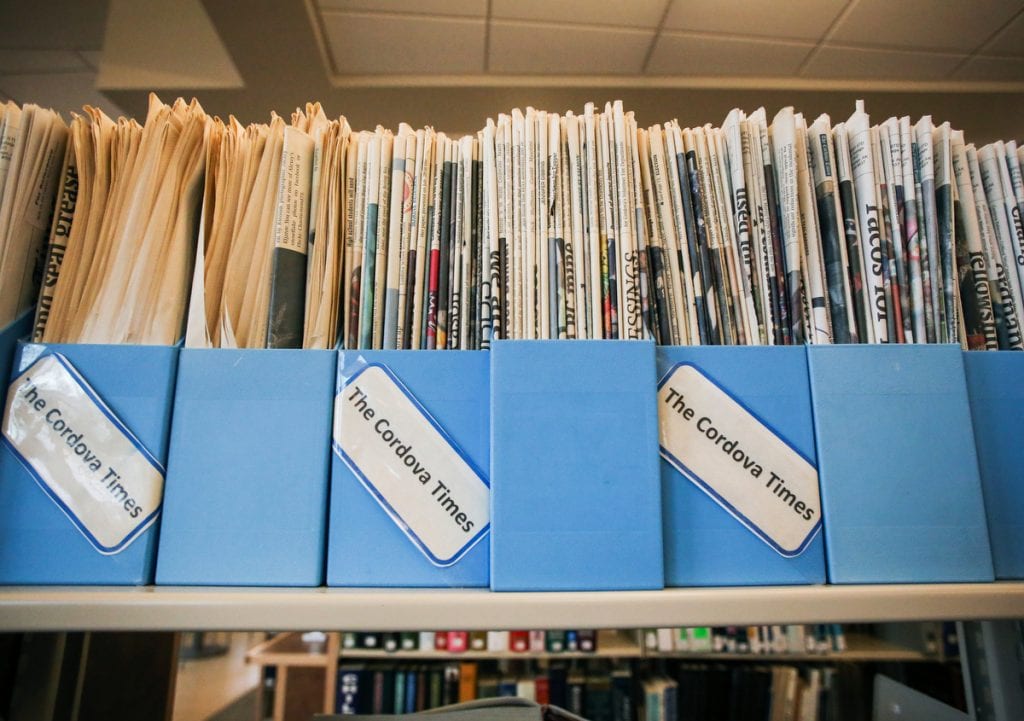
This week is U.S. Media Literacy Week. Established in 2015 by the National Association for Media Literacy Education (NAMLE) and inspired by Canada’s Media Literacy Week, it’s held in conjunction with UNESCO’s Global Media and Information Literacy Week. It’s a celebration and promotion of media literacy in the U.S.
But what is media literacy? It’s commonly defined as a media consumer’s ability to critically analyze articles, stories, and content presented in mass media, and determine its credibility and reliability. This year, NAMLE is highlighting five key components of the media literacy definition: access, analyze, evaluate, create, and act.
Accessing, analyzing and evaluating news
This issue, we are taking readers on a journey through the process of putting together our weekly paper. We hope by being transparent about our journalism process we can empower readers in the first three components of Media Literacy Week: by accessing, analyzing and evaluating the news you consume.
Access refers to how, when, and how often someone has access to technological tools and digital skills. This includes understanding how media and technology work, knowing where to locate resources online, and accessing and engaging in information without censorship. Limited access — such as subpar internet access — can affect one’s ability to engage in culture, share information, learn skills, and participate in civic engagement.
Analyzing media means that consumers are questioning the author, publisher, audience, and technique of a piece of media to determine how credible it is. Consumers can evaluate the media they consume by engaging in self-reflection about how they interpret the media, and draw their own judgment on media messages through information gathering.
To start, NAMLE suggests that readers pose the following questions as they read and digest media:
Who made the media?
When was the media made?
Why was the media made?
Who is the target audience?
Who paid for this, and who makes money for this?
Second NAMLE says to question the messaging of the media:
What does the media want the consumer to think about?
What could someone learn from this media?
What perspectives are included, and what perspectives are left out?
What techniques or formats are used to convey the messaging?
The third round of questions to pose to yourself is about self-reflection. Media consumers should evaluate how their emotions influence their interpretation of the media, what they can learn about their interpretation of the media, how others might consume the messaging differently, if the piece of media is primarily fact or opinion, what the sources are, and how they know they can trust the source to give them credible information.
How The Cordova Times is built
So, what does a week in the life of The Cordova Times look like?
Well, Monday through Wednesday editors edit the stories our journalists have reported on and contributors have submitted. By Wednesday evening all stories are placed in a draft copy of the paper, and then the entire staff then reads through the 16-page paper for any last-minute corrections. Then, our designer sends the final copy to the printer in Anchorage where it is printed Thursday morning. While hard copies of the paper are distributed around the community every Friday, we also publish our articles on our website.
What is a beat?
A beat is a theme or topic that a reporter or editor covers, and is usually signified by a section head in the paper. For example, Margaret Bauman’s beats are primarily fisheries and environment, while Kinsey Brown’s beats are local news and local features. Some of our beats include education, politics, statewide news, marine life, regional news, and health. The beats a paper runs depend in part on its location — not every paper has a dedicated fisheries page like ours does.

What does each position at the paper do?
Managing editor: The managing editor oversees and coordinates the newspaper’s editorial activities. They help maintain the calendar of what articles will run when, and who will cover each story. They also coordinate the art and photographs that run alongside stories. The managing editor oversees day-to-day operations, ensures deadlines are met, and supervises staff. They usually have the most responsibility for the business side of the paper compared to all the other editors. The managing editor also ensures the paper has a strong digital presence on both the website and the paper’s social media.
Editor: An editor finds and assigns stories, and supports reporters in writing these stories. Editors find stories through news tips (for example, press releases or tips emailed to us at share@thecordovatimes.com), events, social media, and independent research. News tips can be informal, such as through word of mouth, or be formal communications from companies, organizations, or community leaders. An editor can support the reporter by helping them connect with contacts (or sources). After the article is written, editors read through the piece to fact check it and correct any spelling, grammar, punctuation, or style errors. Editors have a say in how the article is structured, and can and will delete or rearrange sections that are confusing or unnecessary.
Copy editor: This job is different from an editor because the copy editor usually doesn’t write or contribute to pieces, and doesn’t select content or art. A copy editor reads through each piece to check for spelling, grammar, style, and punctuation mistakes, as well as minor fact checking. The copy editor does this by thoroughly reading the article several times, reviewing dates and name spellings, and generally taking a fine-toothed comb through the piece. Copy editors ensure that the articles follow the style of the paper. The style rules of editing refer to what style guide the paper follows. The Cordova Times follows the Associated Press style guide (also known as AP style), which is standard in journalism. Editors and copy editors are also continuously updating the paper’s in-house style guide, which is a manual with information on how certain words are spelled or if certain phrases are capitalized. Each paper has its own tweaks on grammar and spelling that are reflective of the vernacular and knowledge base of the region it serves. For us, we have a whole section in our in-house style guide about the grammar and spelling of fish names.
Reporter/journalist: The reporter is the one who goes out and interviews sources to craft the story. They write the story based on research and interviews, delivering the who, what, when, where, and why to readers. The reporter works hard to build trust with the community and their stories. The reporter may also take photos to be printed with their article.
Designer: The designer creates the paper each week. They do this by laying out the articles, photos, and advertisements in the shape they will appear in in the paper. (Our designer uses Adobe InDesign to do this.) It’s important that the paper looks familiar to readers each week and we build off the same existing structure. However, each week we have a different set of articles and advertisements of varying lengths and sizes, so the designer will have to find the space to fit each story. The designer also groups the articles by beat.
Advertising and partnerships manager: The advertising manager manages community partnerships and sells advertising space to businesses, organizations and individuals looking to promote their product or service through the paper. The advertising manager generates funding for the paper through selling the ads that appear in the paper. They work closely with the designer on where ads will be placed in the paper. Traditionally, the business (or advertising) side of the paper and the editorial side (reporters and editors) remained separate. Editors and journalists do not sell ad space nor do they determine what ads to run. Likewise, the advertising manager does not tell editors to select stories based on what ads are running or who pays for ad space.
Publisher: The publisher is the owner and operator of the paper. They can have the final say on certain publishing decisions, but are mostly hands-off on the day-to-day side of things. They mostly operate on the business side of the paper, but straddle the divide between the editorial and business/advertising sides of the paper. The publisher usually does a final read through of the paper before it is finished, and helps make business decisions throughout the week. The publisher also oversees all the final hiring processes for the paper.
How is an article built?
The Cordova Times follows the inverted pyramid article structure for articles, a concept practiced in most journalism programs where the most important information is up at the top of the article.
Each article begins with a headline that summarizes the story, and the byline, which lists the author’s name. The body of the article begins with a lede sentence (sometimes spelled lead), which encapsulates the whole point of the article. If someone just reads the headline and the lede they should have a grasp on what happened.
The second and third paragraphs explain the context of the story, or the story in a nutshell. They also start to introduce sources through quotes. Photos run alongside stories to add a visual description to the piece. They are not edited or altered at all before they run, as that would generate inaccuracy in the story. Sometimes, sources will submit a photo they took for the CT to run alongside our article — for example, NOAA will submit a photo of wildlife that we were unable to take and we will place it next to a story about marine mammals. It’s important that the paper gives proper credit to whoever took the photo. The photo caption underneath the photo is meant to provide context for the photo in relation to the article. Sometimes at the bottom of an article you will see an italicized paragraph that serves as a sort of disclaimer and adds context for the story but is not about the topic. For example, this additional paragraph could provide resources for domestic or sexual assault survivors after an article about an increase in the number of cases of domestic assault in the state. An article may contain quotes from a social media post. If a social media post, like a Facebook page post, is public, it is fair for a reporter to quote it in their story.
Community engagement is important to all members of the team, and is especially prized within regional newspapers like ours. That’s why our email inboxes are always open to readers who want to engage with pieces we’ve run, provide news tips, or submit letters to the editor. If a reader notices something they know to be incorrect, they can submit a correction to the paper. We all make mistakes, as much as we try not to, but a credible newspaper runs corrections when they need to.
The important thing to remember is that The Cordova Times is as much your newspaper as it is ours, and your engagement is beyond valuable. Thank you for being our readers, engaging with our content, and supporting local news!














